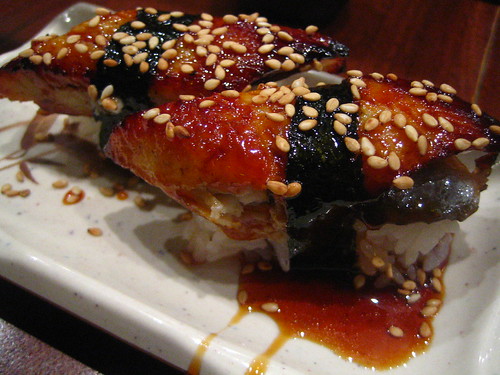Sesame Seeds Increase Absorption of Vitamin E Tocotrienols by Up to 500%
As you may know, I'm currently taking a tocotrienol supplement called Toco-Sorb to see whether it has an effect on hair growth (if you stumbled upon this post by accident, you can read the beginning of the experiment here).
The challenge
A couple of weeks ago I wrote a post about getting tocotrienols from natural sources. The conlusion was that most foods are so low in tocotrienols that getting the whole tocotrienol complex is difficult, if not impossible, without supplements.
Another problem with tocotrienols is that they're poorly absorbed. The figures I've seen are in the 20-30% range, meaning that at best only a third of the tocotrienols are actually absorbed. So even if you forget the natural way and go for the supplement cabinet to get those tocotrienols, the question of bioavailability still remains.
Then how do we increase the bioavailability of tocotrienols? One answer seems to be sesame seeds.
Feeding rats vitamin E and sesame seeds
In their first experiment, Ikeda et al. fed rats tocopherol with or without tocotrienols. In the second experiment, they fed rats tocopherol or tocotrienols with or without sesame seeds.
As both experiments had control groups as well, the rats in the first experiment were divided into three groups: the first one was fed no vitamin E at all, the second one was fed only alpha-tocopherol, and the third one was fed a palm oil extract with alpha-tocopherol, alpha-tocotrienol and gamma-tocotrienol.
In the second experiment the rats were divided into five groups: the first was fed no vitamin E, the second was fed alpha- and gamma-tocopherol, the third was fed alpha-tocopherol and sesame seeds, the fourth was fed the palm fruit extract and gamma-tocopherol, and the fifth was fed the palm fruit extract with sesame seeds.
Tocotrienols are absorbed only by fat and skin tissues
Since it's the second experiment and its sesame seed groups we're interested in, I'll skip analyzing the first experiment in detail.
The researchers found that, in the second experiment, tocotrienols were not detected in any tissues or plasma in the first three groups (no vitamin E, alpha- and gamma-tocopherol, alpha-tocopherol + sesame seeds). Only negligible levels of tocotrienols were detected in the liver, kidney, heart, lung, brain, muscle and plasma of the last two groups (palm fruit extract + gamma-tocopherol, palm fruit extract + sesame seeds).
However, in the last two groups, tocotrienols were detected in fat and skin tissues. The fifth group also had higher levels than the fourth group.
Sesame seeds improve absorption of tocotrienols
What this means is that consuming the palm oil extract resulted in detectable levels of tocotrienols in fat and skin tissues but not in other tissues. So while the bioavailability of tocotrienols might not be optimal, at least some of them are absorbed by fat and skin tissues in rats.
That's good news of course, but even better news is that when sesame seeds were consumed with the extract, the tocotrienol levels were even higher:

The black bar is thus group four, i.e. the one fed palm oil extract and gamma-tocopherol, and the rightmost bar is group five, i.e. the one fed the palm oil extract and sesame seeds. As you can see, only the groups fed palm fruit extract had detectable levels of tocotrienols in perirenal adipose tissues, epidymal fat tissues and skin tissues.
The most interesting thing is how strongly sesame seeds increased the tocotrienol levels in these tissues. In fat tissues alpha-tocotrienol levels increased about 50%, and in skin tissues by about 80%. A pretty significant increase. Even more significant is the effect of sesame seeds on gamma-tocotrienol levels: gamma-tocotrienol levels increased in fat tissues by about 400%, and by about 500% in skin tissues.
These are exciting figures – even higher than the "2-3 times better bioavailability" advertised (but unreferenced) by Jarrow on the label of their Toco-Sorb product.
Applying the results to humans
The amount of sesame seeds used in the study was 200 mg per kg of feed. If we assume the male Wistar rats weighed about 400 grams, and that the rats ate daily about 6% of their body weight in solid food (these seem to be common figures in male rats), we get 24 grams of food per day per rat.
The amount of sesame seeds eaten per day is then 0.2 grams * 24 grams = 4.8 grams. This number may not be directly applicable to humans, but it certainly seems that a huge amount of sesame seeds is not needed to see the increased absorption of tocotrienols. In fact, compared to trying to consume more actual tocotrienols by eating more natural foods, this seems like a remarkably easy way.
Since my experiment is mainly about the effect of tocotrienols on hair growth, the fact that sesame seeds improve absorption into skin tissue is the most interesting result of the study. I'm now adding a tablespoon of sesame seeds (about 9 grams) into my morning smoothie and taking my tocotrienol supplement with it.
For more information on tocotrienols, see these posts:
Getting Tocotrienols from Natural Food Sources: Is It Possible?
Hair Growth with Vitamin E Tocotrienols from Palm Oil – Experiment Conclusion
Vitamin E Tocotrienols May Grow Hair in Humans









3 kommenttia:
If you think that's exciting you may completely lose it when you see this study on the effects of aloe on the bioavailability of C and E (and presumably on all nutrients)
http://www.aloe-vera.ma/presse/Effect%20of%20Aloe%20vera%20preparations%20on%20the%20human%20bioavailability%20of%20vitamins.pdf
Lily of the Valley brand has also funded a study on their own aloesorb formula, the results of which, if accurate, are truly gob smacking.
http://www.aloe-vera.ma/presse/Effect%20of%20Aloe%20vera%20preparations%20on%20the%20human%20bioavailability%20of%20vitamins.pdf
You probably won't answer, but could you link this study? I've been researching the net and found it nowhere..
@JohnB,
There's a link to the study in the blog post, but here it is:
http://jn.nutrition.org/cgi/pmidlookup?view=long&pmid=11694614
- JLL
Post a Comment